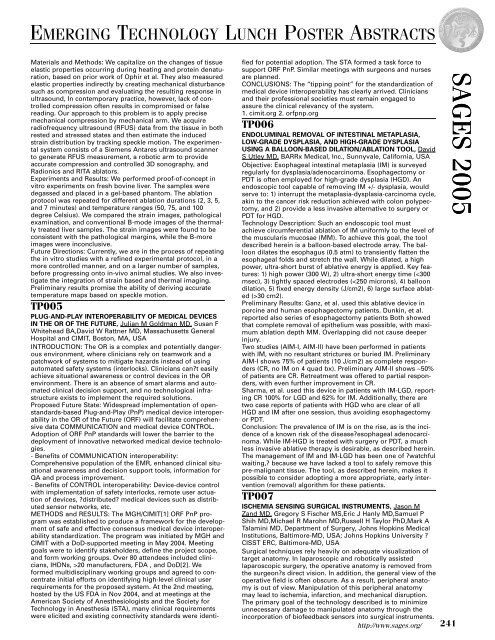2005 SAGES Abstracts
2005 SAGES Abstracts
2005 SAGES Abstracts
Create successful ePaper yourself
Turn your PDF publications into a flip-book with our unique Google optimized e-Paper software.
EMERGING TECHNOLOGY LUNCH POSTER ABSTRACTS<br />
Materials and Methods: We capitalize on the changes of tissue<br />
elastic properties occurring during heating and protein denaturation,<br />
based on prior work of Ophir et al. They also measured<br />
elastic properties indirectly by creating mechanical disturbance<br />
such as compression and evaluating the resulting response in<br />
ultrasound, In contemporary practice, however, lack of controlled<br />
compression often results in compromised or false<br />
reading. Our approach to this problem is to apply precise<br />
mechanical compression by mechanical arm. We acquire<br />
radiofrequency ultrasound (RFUS) data from the tissue in both<br />
rested and stressed states and then estimate the induced<br />
strain distribution by tracking speckle motion. The experimental<br />
system consists of a Siemens Antares ultrasound scanner<br />
to generate RFUS measurement, a robotic arm to provide<br />
accurate compression and controlled 3D sonography, and<br />
Radionics and RITA ablators.<br />
Experiments and Results: We performed proof-of-concept in<br />
vitro experiments on fresh bovine liver. The samples were<br />
degassed and placed in a gel-based phantom. The ablation<br />
protocol was repeated for different ablation durations (2, 3, 5,<br />
and 7 minutes) and temperature ranges (50, 75, and 100<br />
degree Celsius). We compared the strain images, pathological<br />
examination, and conventional B-mode images of the thermally<br />
treated liver samples. The strain images were found to be<br />
consistent with the pathological margins, while the B-more<br />
images were inconclusive.<br />
Future Directions: Currently, we are in the process of repeating<br />
the in vitro studies with a refined experimental protocol, in a<br />
more controlled manner, and on a larger number of samples,<br />
before progressing onto in-vivo animal studies. We also investigate<br />
the integration of strain based and thermal imaging.<br />
Preliminary results promise the ability of deriving accurate<br />
temperature maps based on speckle motion.<br />
TP005<br />
PLUG-AND-PLAY INTEROPERABILITY OF MEDICAL DEVICES<br />
IN THE OR OF THE FUTURE, Julian M Goldman MD, Susan F<br />
Whitehead BA,David W Rattner MD, Massachusetts General<br />
Hospital and CIMIT, Boston, MA, USA<br />
INTRODUCTION: The OR is a complex and potentially dangerous<br />
environment, where clinicians rely on teamwork and a<br />
patchwork of systems to mitigate hazards instead of using<br />
automated safety systems (interlocks). Clinicians can?t easily<br />
achieve situational awareness or control devices in the OR<br />
environment. There is an absence of smart alarms and automated<br />
clinical decision support, and no technological infrastructure<br />
exists to implement the required solutions.<br />
Proposed Future State: Widespread implementation of openstandards-based<br />
Plug-and-Play (PnP) medical device interoperability<br />
in the OR of the Future (ORF) will facilitate comprehensive<br />
data COMMUNICATION and medical device CONTROL.<br />
Adoption of ORF PnP standards will lower the barrier to the<br />
deployment of innovative networked medical device technologies.<br />
- Benefits of COMMUNICATION interoperability:<br />
Comprehensive population of the EMR, enhanced clinical situational<br />
awareness and decision support tools, information for<br />
QA and process improvement.<br />
- Benefits of CONTROL interoperability: Device-device control<br />
with implementation of safety interlocks, remote user actuation<br />
of devices, ?distributed? medical devices such as distributed<br />
sensor networks, etc.<br />
METHODS and RESULTS: The MGH/CIMIT[1] ORF PnP program<br />
was established to produce a framework for the development<br />
of safe and effective consensus medical device interoperability<br />
standardization. The program was initiated by MGH and<br />
CIMIT with a DoD-supported meeting in May 2004. Meeting<br />
goals were to identify stakeholders, define the project scope,<br />
and form working groups. Over 80 attendees included clinicians,<br />
IHDNs, >20 manufacturers, FDA , and DoD[2]. We<br />
formed multidisciplinary working groups and agreed to concentrate<br />
initial efforts on identifying high-level clinical user<br />
requirements for the proposed system. At the 2nd meeting,<br />
hosted by the US FDA in Nov 2004, and at meetings at the<br />
American Society of Anesthesiologists and the Society for<br />
Technology in Anesthesia (STA), many clinical requirements<br />
were elicited and existing connectivity standards were identified<br />
for potential adoption. The STA formed a task force to<br />
support ORF PnP. Similar meetings with surgeons and nurses<br />
are planned.<br />
CONCLUSIONS: The “tipping point” for the standardization of<br />
medical device interoperability has clearly arrived. Clinicians<br />
and their professional societies must remain engaged to<br />
assure the clinical relevancy of the system.<br />
1. cimit.org 2. orfpnp.org<br />
TP006<br />
ENDOLUMINAL REMOVAL OF INTESTINAL METAPLASIA,<br />
LOW-GRADE DYSPLASIA, AND HIGH-GRADE DYSPLASIA<br />
USING A BALLOON-BASED DILATION/ABLATION TOOL, David<br />
S Utley MD, BARRx Medical, Inc., Sunnyvale, California, USA<br />
Objective: Esophageal intestinal metaplasia (IM) is surveyed<br />
regularly for dysplasia/adenocarcinoma. Esophagectomy or<br />
PDT is often employed for high-grade dysplasia (HGD). An<br />
endoscopic tool capable of removing IM +/- dysplasia, would<br />
serve to: 1) interrupt the metaplasia-dysplasia-carcinoma cycle,<br />
akin to the cancer risk reduction achieved with colon polypectomy,<br />
and 2) provide a less invasive alternative to surgery or<br />
PDT for HGD.<br />
Technology Description: Such an endoscopic tool must<br />
achieve circumferential ablation of IM uniformly to the level of<br />
the muscularis mucosae (MM). To achieve this goal, the tool<br />
described herein is a balloon-based electrode array. The balloon<br />
dilates the esophagus (0.5 atm) to transiently flatten the<br />
esophageal folds and stretch the wall. While dilated, a high<br />
power, ultra-short burst of ablative energy is applied. Key features:<br />
1) high power (300 W), 2) ultra-short energy time (
















